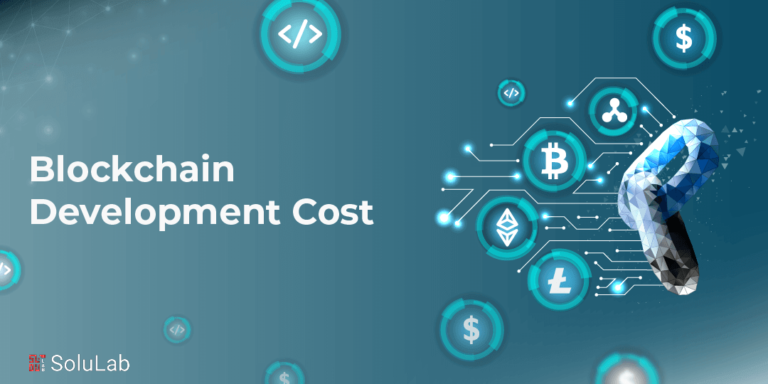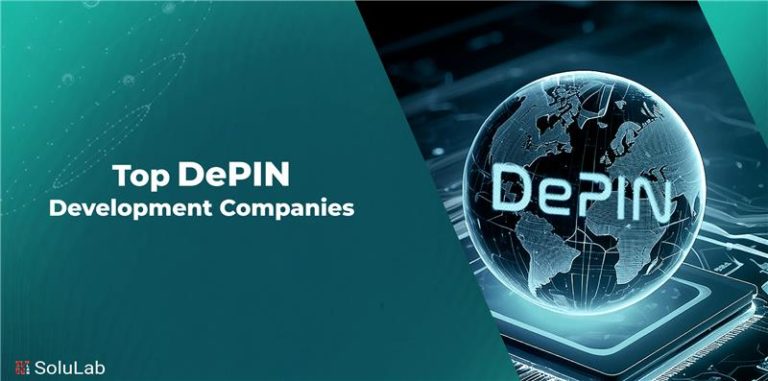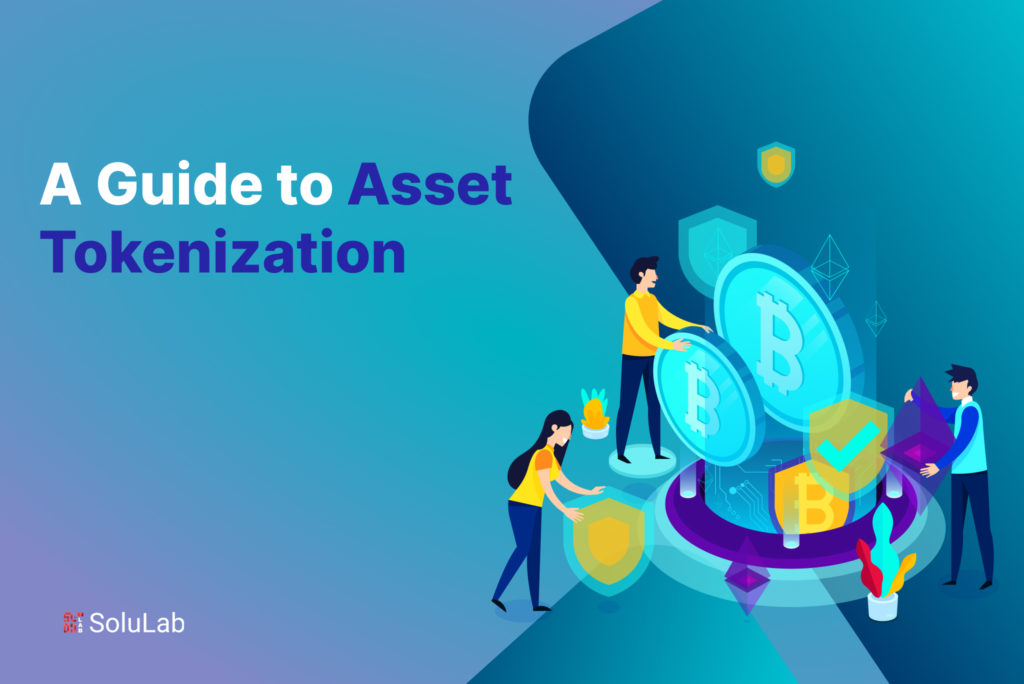
The emergence of blockchain technology began a new era of possibilities, redefining the way we create, manage, and trade assets and investments. Whether it is real estate property, important documents, favorite vehicles, or company shares, everything is tokenized on the Blockchain network. So what is Asset Tokenization?
Asset Tokenization (A Brief Introduction)
Tokenization is the transformative process of converting ownership and rights related to specific assets into a digital format. This method allows for the conversion of indivisible assets into tokenized representations.
To understand better, let’s take an example of an iconic painting, the Mona Lisa. To sell it traditionally, you’d need to find a buyer with the financial means to spend millions of dollars. This limits the pool of potential buyers significantly. However, through tokenization, we can fragment ownership of the painting, making it accessible to multiple individuals. Therefore, one person may own, for example, 1/25th of the painting or asset. This level of division is achievable only through tokenization, offering a modern solution compared to conventional methods.
Read Our Blog: Top 10 Asset Tokenization Platforms in 2024
Asset Tokenization On Blockchain: Explained
Asset tokenization on a blockchain is changing the way we think about ownership and investing. Essentially, it involves converting actual or digital assets, such as stocks, commodities, real estate, or works of art, into digital tokens that are stored on a blockchain.
Blockchain provides essential elements like decentralization, transparency, immutability, and secure record-keeping that guarantees the token holder’s ownership rights are secure and unchangeable, boosting confidence and security. These tokens further allow for fractional ownership and simple transferability. Investors can purchase and sell portions of valuable properties, and diversifying their portfolios is made simpler.
Additionally, Blockchain eliminates the need for middlemen, expediting transactions and cutting expenses.
Application of Smart Contracts in Tokenized Assets
In tokenized assets, smart contracts, or self-executing agreements, play a crucial role. They automatically uphold the rules of the contract, outlining token holders’ ownership rights and responsibilities, including dividend payments and voting powers.
Asset Tokenization on Blockchain: Potential Benefits
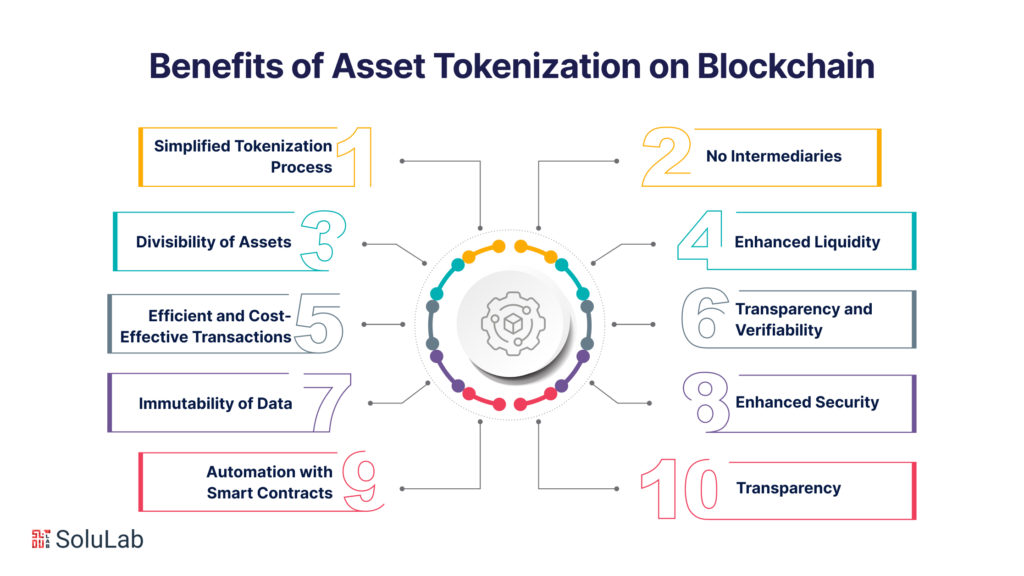
Tokenizing assets on the blockchain opens up significant growth and diversification opportunities in the market by bringing a plethora of new opportunities for businesses and individuals such as continuous operation, round-the-clock data accessibility, and immediate settlement possibilities.
-
Simplified Tokenization Process
In blockchain-based tokenization, the blockchain infrastructure replaces traditional banks, and cryptocurrency tokens replace digital dollars. While the mechanics change, the fundamental tokenization process remains similar to traditional banking, forex trading, or stock market tokenization.
-
No Intermediaries
Asset tokenization on the blockchain eliminates the intermediaries in the trading process. The distributed ledger system becomes a “source of truth” that ensures transaction integrity, securely stores digitized assets and facilitates transactions. Trust is primarily placed in the issuer and relevant regulatory bodies, simplifying and cost-reducing the process while enhancing security.
-
Divisibility of Assets
Tokenization can divide any asset into an unlimited number of virtual shares, each represented by a separate token. This feature enhances liquidity in markets where it was previously limited.
Consider real estate investments. Traditionally, buying or renting an entire building can be prohibitively expensive. However, using blockchain to divide a building into 100 tokens, each costing $2,500, reduces the investment threshold to $250.
Similar divisibility applies to intellectual property, pharmaceutical development, space research, and even entire countries, enabling greater citizen involvement in political processes.
-
Enhanced Liquidity
Tokenizing assets broadens their accessibility, amplifying market liquidity by removing the traditional obstacles associated with illiquid investments, such as fine art or real estate. Tokenized assets can be seamlessly exchanged online, enabling investors to acquire fractional ownership in the underlying asset. In addition to increasing the liquidity of existing markets, this double effect opens up a wider range of investment opportunities to a wider range of investors.
-
Efficient and Cost-Effective Transactions
Crypto tokens eliminate the need for intermediaries and intermediaries, prevalent in traditional asset management processes. As a result, the value transfer process becomes more efficient and cost-effective by a reduction in transaction costs and processing time. Moreover, crypto tokens, residing on blockchain technology, facilitate 24/7 global trading, providing uninterrupted accessibility and flexibility.
-
Transparency and Verifiability
Crypto tokens’ residence on the blockchain ensures transparent provenance and transaction histories, cryptographically verifiable by users. Blockchain automatically records transactions, and its immutable and transparent nature guarantees the authenticity of each token’s historical data. These attributes endow crypto tokens with a level of trustworthiness rarely matched by other digital assets.
-
Immutability of Data
Data recorded on the blockchain cannot be altered, deleted, or tampered with by bribing officials or hacking systems. This inherent feature is due to blockchain architecture, which records information in blocks.
This immutability makes blockchains suitable for state registries, online banking systems, and corporate databases where data accuracy is paramount. It ensures the ability to trace the history of tokens or assets, deterring fraud, theft, errors, or corruption.
-
Enhanced Security
Blockchain Tokenization relies on cryptography and distributed registries. Cryptography safeguards open data by encrypting it with secret algorithms and keys. This enables secure storage of confidential or financial information while maintaining transparency.
These security measures enhance the safety of stored information in Token, including owner details and billing information.
-
Automation with Smart Contracts
Blockchain enables the automation of most workflow and bureaucratic procedures through smart contracts—autonomous algorithms that facilitate the exchange of assets like money, stocks, tokens, or real estate.
Smart contracts automate processes, eliminate intermediaries, accelerate transactions, reduce costs, and combat corruption. They operate based on predefined conditions, executing actions when certain criteria are met.
-
Transparency
Most blockchains are open-source software, allowing users and developers to inspect the code for vulnerabilities and functionality. This transparency ensures compliance with regulations, reduces fraud risk, and instills confidence in issuers and their assets.
How Does Asset Tokenization Profit the Asset Owners?
- Tokenizing assets allows for fractional ownership, increasing liquidity by enabling the sale of smaller portions without sacrificing the asset’s utility.
- Asset tokenization establishes a transparent market, eliminating illiquidity discounts and enabling owners to set fair market prices.
- Utilizing decentralized platforms automates asset transfers, reducing the need for costly intermediaries and saving time.
Read Our Blog Also: Top 12 Real Estate Tokenization Companies in USA
How Does Asset Tokenization Profit the Investors?
- Investors can easily diversify their portfolios by investing small amounts in tokenized assets, enhancing liquidity, and reducing paperwork hassles.
- Tokenization enables quicker asset liquidity, eliminating long lock-up periods and allowing investors to access profits or make adjustments sooner.
- Blockchain-based asset history ensures transparency, enabling investors to make informed decisions based on an asset’s true background.
- Decentralized identity and blockchain technology provide secure, verifiable ownership and identity verification, meeting KYC/AML requirements and ensuring trust across various platforms.
Additional Features
In addition to the above benefits, tokenization offers a wide range of possibilities, including trading, storage, collateral usage, payment for goods and services, participation in loyalty programs, voting, and access to blockchain platforms.
Type of Tokenized Assets
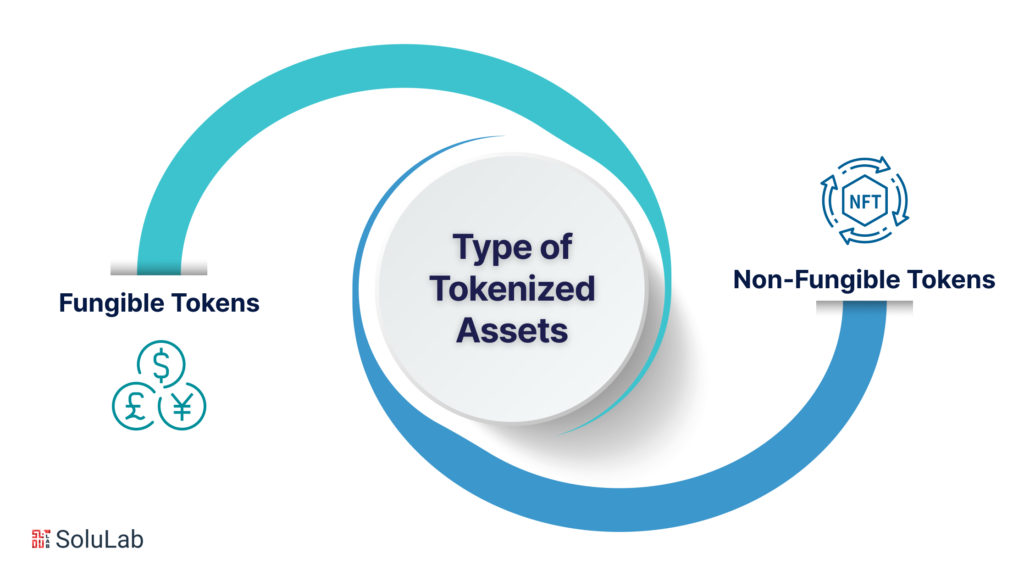
The tokenized assets can further broadly be categorized into two types: Fungible Tokens and Non-Fungible Tokens
Fungible Tokens
Fungible tokens refer to an asset that can be exchanged for another identical asset of the same type. When a good or service is fungible, it means it can be substituted with another identical good or service without any distinction.
Main Features:
-
Divisible
Fungible tokens are divisible into smaller units, allowing holders to acquire any number of these units without affecting the total value. The divisibility of these tokens ensures flexibility for users.
-
Uniform
Fungible tokens are uniform in nature, which means that each token is indistinguishable from all other tokens of the same type. For instance, one $50 bill is identical to any other $50 bill.
-
Exchangeable
Fungible tokens can be exchanged for any other tokens of the same type, independent of their past ownership or transactional histories. The trading and liquidity in markets are made simpler by this interchangeability.
-
Stable Value
Fungible tokens have a stable value over their entire supply. For users and investors, fungible tokens offer certainty because each unit is worth the same as any other unit of the same kind.
Non-Fungible Tokens
Non-fungible tokens signify that each token is unique and cannot be replaced by an identical token. These tokens possess distinct characteristics, making them individual and irreplaceable. This uniqueness imparts a higher intrinsic value to NFTs compared to fungible tokens.
Main Features
-
Non-Divisible
Non-fungible tokens, cannot be divided into smaller fractions. They exist as whole entities, and there is no way to split them into smaller parts.
-
Unique
Non-fungible tokens are characterized by their uniqueness. All tokens of the same type share identical specifications, and each individual token is identical to every other token of that type, ensuring their distinctiveness in the digital space.
-
Ownership and Provenance
Non-fungible tokens have a distinct benefit in demonstrating ownership and provenance. A transparent and safe method of confirming authenticity is provided by each NFT’s unique digital identity, which can be used to trace it back to its original inventor.
-
Diverse Use-Cases
Non-fungible tokens can be used for a variety of purposes other than only representing digital artwork or goods. They are used in industries like real estate, gaming, intellectual property, etc., where unique assets or rights need to be tokenized and managed digitally.
Things That Can be Tokenized
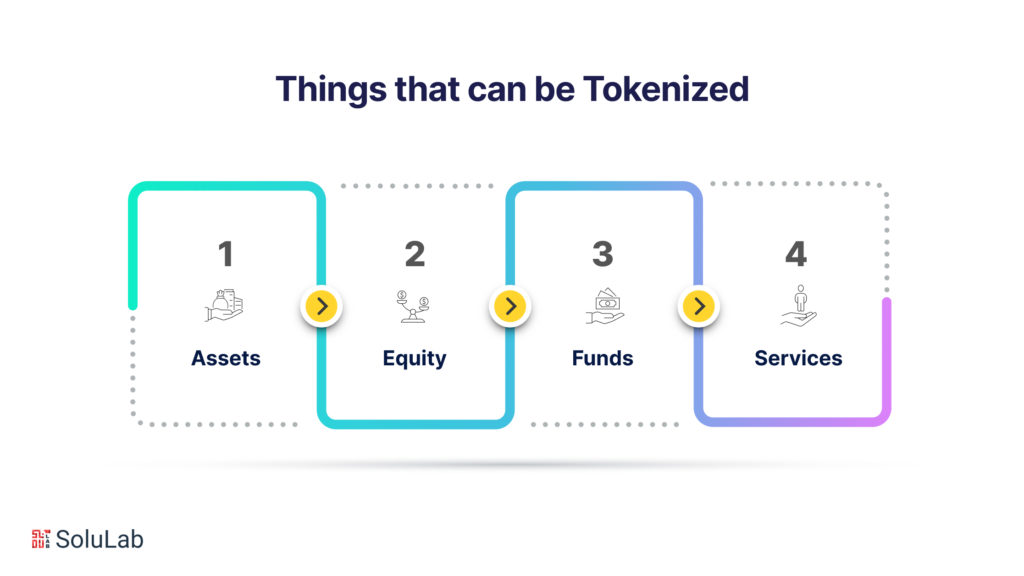
From conventional assets like venture capital funds, bonds, commodities, and real estate properties to unconventional assets such as sports teams, racehorses, artwork, and even celebrity endorsements, individuals and businesses can use blockchain technology to tokenize anything.
Here are the primary categories that may benefit from the tokenization:
Assets: The category encompasses anything of value that can be converted into cash. It can be further classified into two subcategories:
- Personal Assets- This includes cash and property.
- Business Assets- These comprise items listed on a company’s balance sheet.
Equity: Equity, in the form of shares, can also be tokenized. These digital security tokens are securely stored online in a digital wallet. Investors can typically trade these tokens on a stock exchange.
Related: Real-World Asset Tokenization
Funds: Investment funds are another asset class that investors can tokenize. These tokens represent an investor’s proportional ownership stake in the fund, with each investor receiving tokens corresponding to their share.
Services: Businesses can take advantage of tokenization to offer goods or services as a means of raising funds or facilitating transactions. Investors can employ tokens to purchase goods or services provided by the business entity.
Types of Tokens Circulated and Used in Blockchain World
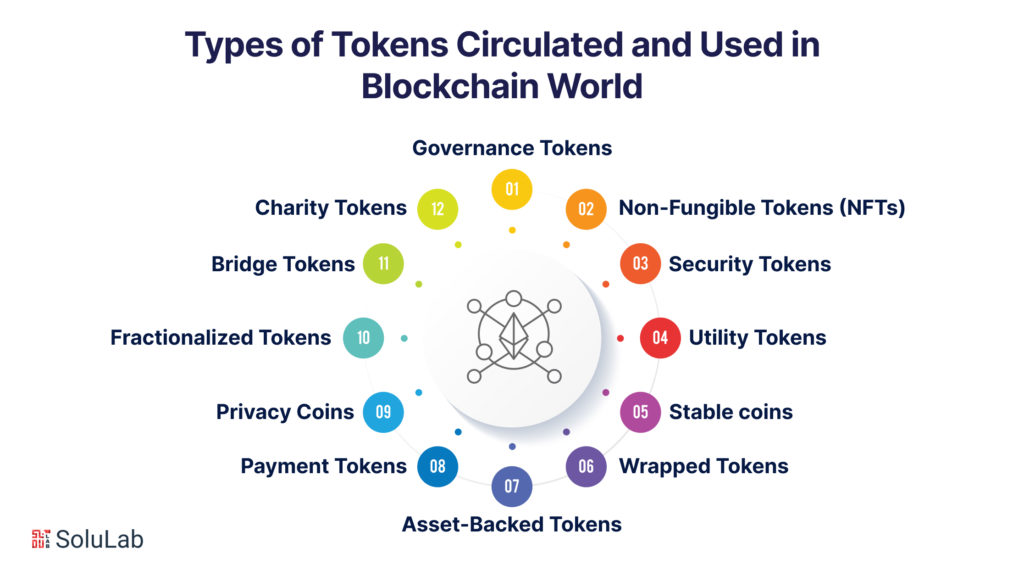
There are multiple types of Tokens circulated and used in the Blockchain world. Each of them has a distinct purpose and use case. Here are the most prevalent types of crypto tokens:
Governance Tokens: Governance tokens grant holders voting privileges within a specific cryptocurrency project. This empowers token holders to initiate and participate in decisions that shape the future of that particular cryptocurrency. The greater the number of tokens one possesses, the greater their influence in the decision-making process.
Non-Fungible Tokens (NFTs): NFTs represent ownership of a digital asset, with ownership records securely stored within the crypto token itself. NFTs find use in establishing ownership of unique digital content such as images, GIFs, or in-game characters.
Security Tokens: This emerging asset class aims to provide the crypto equivalent of conventional securities, such as stocks and bonds. Security tokens primarily facilitate the sale of company shares without the necessity of intermediaries like brokers. Prominent corporations and startups are actively exploring security tokens as a potential alternative fundraising method.
Utility Tokens: These tokens are created to provide access to a specific product or service within blockchain ecosystem protocols. Examples include Binance Coin (BNB) for transaction fee discounts on the Binance exchange and Filecoin (FIL) for storage services on the Filecoin network.
Stablecoins: These tokens are designed to have a stable value, often pegged to a fiat currency like the US Dollar (e.g., USDC, USDT) or backed by collateral assets. Stablecoins are used to mitigate the volatility associated with other cryptocurrencies.
Wrapped Tokens: Issued on one blockchain (e.g. Ethereum) these tokens represent the equivalent value of another blockchain’s native asset (e.g., Wrapped Bitcoin or WBTC represents Bitcoin on the Ethereum network). They enable assets from one blockchain to be used in decentralized applications on another.
Asset-Backed Tokens: Backed by physical assets or commodities, Asset-backed tokens offer digital representation and easy transferability. For example: Gold-backed tokens represent ownership of a specific amount of physical gold.
Payment Tokens: Payment tokens are used for transactions and payments within a particular ecosystem or platform. They may offer lower transaction fees and faster confirmation times compared to traditional cryptocurrencies.
Privacy Coins: These tokens prioritize privacy and anonymity in transactions. Examples include Monero (XMR) and Zcash (ZEC), which employ advanced cryptographic techniques to obscure transaction details.
Fractionalized Tokens: They represent fractional ownership of high-value assets, such as real estate or art, enabling more people to invest in and trade these assets.
Bridge Tokens: By facilitating interoperability, bridge token assets can be transferred seamlessly between multiple blockchains. For example: Polka Dots DOT and Cosmos’ ATOM.
Charity Tokens: Tokens created for charitable purposes, where a portion of transactions or token holdings goes to support specific causes or organizations.
How Does Asset Tokenization Work?
The working of tokenization on the Blockchain network involves replacing sensitive information with an equivalent, non-sensitive placeholder known as a “token.” These tokens can be generated through several methods:
- Using a mathematically reversible cryptographic function with a specific key.
- Employing non-reversible functions, such as a hash function.
- With indexing functions or generating a random number.
As a result, the token takes the place of sensitive information, while the actual sensitive data it represents is securely stored in a server referred to as a “token vault.” The token vault serves as the sole location where the original information can be mapped back to its corresponding token, ensuring the safeguarding of sensitive data.
The Steps Involved in the Tokenization Process

1. Asset Selection- Select an asset, for example- a piece of art, intellectual property right, or house to tokenize.
2. Asset Valuation- In this step, asset evaluation is done to determine its value, and parameters are set to understand the worth of the digital token
3. Token Creation: After determining the value, the token is created using Blockchain technology. The token contains information related to the asset it represents such as ownership information, benefits, and rights.
4. Legal and Compliance– As per the jurisdiction, a token must fulfill the regulatory requirements and legal agreements. The process ensures that created tokens adhere to the applicable laws and regulations.
5. Token Offering – The token created now can be made available for sale. The interested party who purchases the token will become the owner of the faction and the entire token as per the purchase agreement.
Properties of Tokenized Real-World Assets
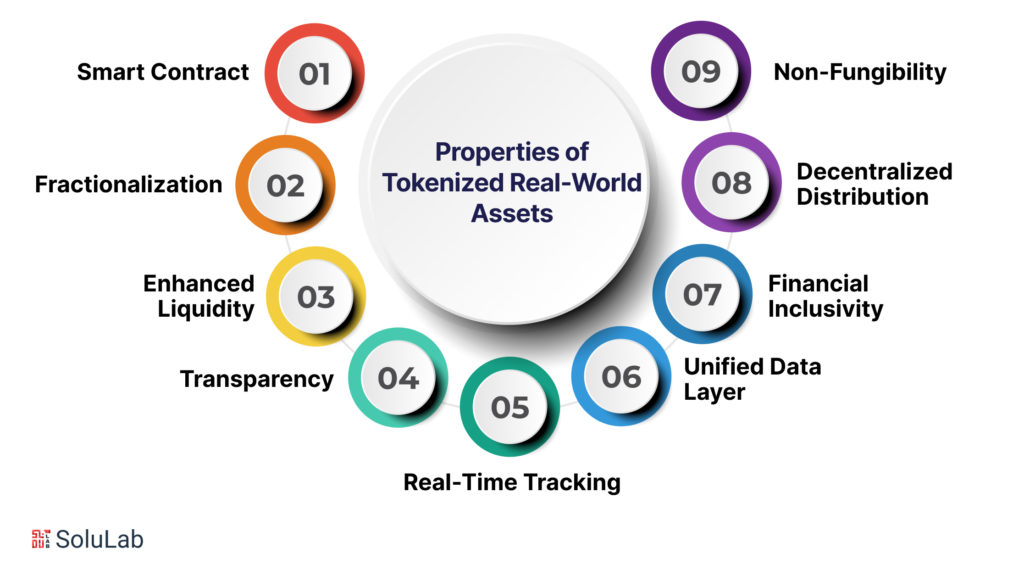
-
Smart Contract
The tokenization of real-world assets is achieved through the deployment of smart contracts. These self-executing contracts contain predefined instructions and automatically execute when specified conditions are met. This innovative approach promotes decentralization and eliminates the necessity for third-party intermediaries in transaction processes.
-
Fractionalization
Real-world assets can be subdivided into numerous digital tokens within the blockchain ecosystem. This fractionalization enhances liquidity and fosters financial inclusivity. For instance, a $1 million commercial building can be fragmented into one million digital tokens, each valued at just $1, thereby significantly reducing the investment threshold.
-
Enhanced Liquidity
Asset tokenization enhances liquidity by simplifying asset trading and transfers within a unified platform. Digital tokens can be freely and instantaneously exchanged in a peer-to-peer manner, obviating the need for intermediary financial institutions.
-
Transparency
Tokenized real-world assets are the real-world tokens present on a blockchain, which inherently offers transparency. Blockchain users can check the transaction records, trace the asset’s origins, scrutinize its complete history, and validate ownership.
-
Real-Time Tracking
As blockchains are transparent, they enable real-time tracking of tokenized assets, effectively deterring fraudulent activities. Central banks worldwide are adopting fiat currency in tokenized form, known as CBDC – “Central Bank Digital Currency”, that users can continuously monitor.
-
Unified Data Layer
Blockchain technology streamlines data management by providing a unified data layer. This facilitates more efficient data sharing and collaboration among multiple parties involved in asset management.
-
Financial Inclusivity
Digital tokens can be issued by a wide range of entities, from small-sized businesses to big-scale industries, individuals, private companies, and non-governmental organizations, without the need for approval from traditional financial institutions. However, if these tokens are classified as securities, registration with regulatory bodies like the U.S. Securities and Exchange Commission may be required. Additionally, asset fractionalization lowers the entry barrier, promoting financial inclusivity.
-
Decentralized Distribution
Digital tokens can be easily distributed without reliance on third-party intermediaries. Token issuers have the flexibility to list their tokens on DEXs or can sell them autonomously.
-
Non-Fungibility
Non-fungible digital tokens (NFTs), which are unique and irreplaceable. Unlike fungible tokens like ETH, each NFT is distinct and non-replicable.
Risk and Challenges to Adoption of Tokenization
Despite the potential advantages that tokenization promises, its widespread adoption has persistent challenges. One noteworthy exception to this trend is the tokenization of cash, primarily in the form of fully backed “stablecoins” and tokenized bank deposits.
Why hasn’t digital asset tokenization gained widespread acceptance thus far? Several factors have contributed to this:
Technology and Infrastructure Readiness:
The current infrastructure has limitations that hinder tokenization adoption. These include a shortage of robust institutional-grade digital asset custody and wallet solutions, particularly those offering flexibility in managing account policies such as trading limits. Additionally, blockchain technology, especially public permissionless versions, has struggled with system uptime under high transaction volumes—unacceptable for certain use cases, especially in mature capital markets.
The fragmented private blockchain infrastructure further compounds issues with interoperability, introducing risks, liquidity fragmentation, and data harmonization challenges.
Limited Short-Term Business Viability and High Implementation Costs
Tokenization’s economic benefits are most apparent at scale when a significant portion of assets or use cases have transitioned to the new digital framework. However, achieving this scale requires a costly transition to adapt middle- and back-office workflows that were not originally designed for tokenized assets. This results in unclear short-term benefits and a challenging business case for gaining organizational support.
Additionally, transitioning often necessitates running parallel digital and traditional operations to mitigate operational and regulatory risks, further complicating the business case. Some legacy clients in capital markets have yet to express interest in 24/7 infrastructure and value movement, posing additional obstacles to tokenized product adoption.
Market Immaturity
Tokenization’s promise of faster settlement times and enhanced capital efficiency depends on instantaneous cash settlement. However, no cross-bank solution exists at scale, despite progress in this area. Tokenized deposits are limited to individual banks, and stablecoins lack the necessary regulatory clarity to offer real-time ubiquitous settlement. The tokenization provider landscape remains fragmented and nascent, lacking an integrated, established one-stop shop with the requisite licenses and capabilities.
Furthermore, there’s a lack of widespread distribution channels for digital assets accessible to appropriate investors, in contrast to the established channels used by wealth and asset managers.
Read Also: 9 Blockchain Real Estate Companies to Watch in 2024
Regulatory Uncertainty
Regulatory frameworks for tokenization vary significantly by region or are entirely absent. US players face challenges related to settlement finality, the legal status of smart contracts, and custodial requirements that remain unclear. The treatment of digital assets for capital purposes remains uncertain, with the US Securities and Exchange Commission imposing stricter standards for digital assets than traditional ones, making it cost-prohibitive for banks to hold or distribute digital assets.
Industry Alignment
Capital market infrastructure players have yet to demonstrate a collective commitment to developing tokenization capabilities or transitioning markets to the blockchain. Their involvement is crucial as they are the recognized holders of the books of record. Incentives to migrate to new infrastructure may be misaligned, as some intermediary functions could become obsolete or undergo significant changes.
Even asset classes like carbon credits face challenges in achieving alignment on a standardized registry, with only Gold Standard currently preparing to support tokenized carbon credits publicly, despite the clear benefits of increased transparency.
Industries That are Embracing the Concept of Tokenization of Assets

-
Finance
The finance sector has effectively utilized blockchain technology, namely payment tokenization, to significantly transform its operational processes. The process of tokenization has significantly transformed the concept of assets by enabling efficient exchange services and bolstering data security measures, hence mitigating the necessity of storing vulnerable credit card information. Furthermore, the year 2020 witnessed the emergence of decentralized finance (DeFi), which brought about significant disruptions by providing a diverse array of financial goods and services that operate independently from conventional institutional frameworks. Decentralized Finance (DeFi), characterized by lending protocols and yield-farming tokens, has the capacity to fundamentally transform the global banking and lending sectors, irrespective of prevailing local financial circumstances.
-
Real Estate
The use of blockchain technology in the real estate industry has facilitated the adoption of asset tokenization, resulting in enhanced efficiency in investment procedures by removing middlemen and providing cost-effective platforms for buyer-seller engagements. The process of tokenization plays a crucial role in fostering market variety and acts as a safeguard against fraudulent activities. Tokenization is a process that involves describing properties as blockchain tokens. This method facilitates the division of ownership into smaller fractions, hence enabling fractional ownership. Consequently, tokenization promotes the seamless trading of property shares on secondary markets. This technique effectively improves liquidity and promotes the democratization of real estate investments, hence expanding accessibility to a wider range of individuals.
-
Healthcare
The healthcare sector is now investigating the concept of asset tokenization as a potential solution to address prevailing difficulties, particularly in the areas of data security and supply chain management. Tokenization is a process employed in healthcare blockchain systems wherein sensitive patient data is substituted with non-sensitive representations. This practice empowers individuals and healthcare organizations by providing them with ownership over personal information. Tokens in the pharmaceutical industry serve as distinct units of medication, facilitating safe authentication using tamper-proof QR codes. The implementation of this particular approach serves to augment the levels of transparency and trustworthiness within the supply chain, effectively mitigating the proliferation of counterfeit pharmaceutical products. Consequently, this measure plays a crucial role in safeguarding the well-being and security of patients.
-
Retail
Tokenization has become a prominent technique within the retail sector, serving to improve user experiences and strengthen security measures. Through blockchain tokenization, businesses have the ability to provide customers with enhanced payment choices that are both more safe and convenient. The process of payment tokenization allows users to do transactions without divulging their credit card information, hence mitigating the potential for data breaches and fraudulent activities. Furthermore, businesses have the capability to convert consumer loyalty points and rewards into tokens, enhancing their accessibility and transferability across diverse stores and platforms. This practice not only cultivates client loyalty but also streamlines the administration of loyalty programs for shops.
Read Also: The Ultimate Guide to Investing in Tokenized Real Estate
-
Supply Chain
The use of tokenization has had a transformative impact on the supply chain sector, enhancing several aspects such as transparency, traceability, and operational effectiveness. Companies have the capability to tokenize many aspects of their operations, including goods, shipments, and inventories, by using blockchain technology. This enables stakeholders to effectively monitor and trace the movement and status of these assets across the whole supply chain process. Transparency plays a crucial role in addressing challenges like counterfeiting, theft, and fraud, while also guaranteeing the integrity and genuineness of products. Tokenization is a method that effectively simplifies various operations, such as payments and documentation, resulting in a reduction in paperwork and administrative burdens. Consequently, supply chains exhibit enhanced agility and responsiveness, thereby facilitating expedited delivery and cost reduction for enterprises.
-
Entertainment
Blockchain tokenization is significantly transforming the processes of content creation, distribution, and monetization within the entertainment sector. Content producers have the ability to tokenize their digital assets, including many forms such as music, films, and art. This process empowers individuals by granting enhanced authority over their intellectual property and the royalties associated with it. Blockchain technology has the potential to facilitate the automated management of licensing, copyrights, and revenue-sharing agreements, therefore guaranteeing equitable remuneration for artists. In addition, tokenization is creating opportunities for crowdfunding and investment in artistic endeavors, allowing enthusiasts and financiers to provide support to their preferred artists and acquire a stake in their achievements. The process of democratizing the entertainment business possesses the capacity to disrupt conventional frameworks and bestow authority upon both content creators and consumers.
Real-World Use Cases (Applications) of Asset Tokenization

Tokenization is revolutionizing various industries by leveraging blockchain technology to transform real-world assets into digital tokens, thereby enhancing liquidity and accessibility. Here are some real-life use cases where tokenization is making a significant impact.
-
Tokenization of Real Estate Assets
In the realm of real estate tokenization entails breaking down traditionally illiquid property assets into fungible blockchain tokens.
Elevated Returns, an asset management firm based in New York, demonstrated the potential of this approach by tokenizing the St. Regis Resort in Aspen, Colorado, worth $18 million on the Ethereum blockchain in 2018.
-
Tokenization of Artwork
Tokenization extends its influence to the world of art. Consider the scenario where a company holds ownership of a limited number of prints of an artwork by a renowned artist. These prints can be tokenized, allowing the public to redeem tokens for physical copies. If the value of tokens redeemed falls short of a certain threshold, token holders can retain fractional ownership based on the assessed value.
TheArtToken (TAT) offers tokens representing partial ownership of Contemporary and post-war art, securely stored by the Swiss government. This approach simplifies the buying and selling of art fractions.
-
Tokenization of Physical Commodities
Even in the realm of physical commodities, tokenization is making strides. Take the example of gold stored in a vault owned by ABC. ABC can tokenize ownership of a portion of the gold, maintaining an ownership registry with the vault owner, XYZ. Each token sold represents ownership of a corresponding amount of gold. Token holders can redeem their gold by proving ownership via a digital signature or certificate.
JP Morgan, a financial services giant, has revealed plans to tokenize gold bars on their Quorum blockchain network. This showcases the potential for tokenization in the world of physical assets.
-
Tokenization in Cargo
In the logistics sector, tokenization addresses the inefficiencies associated with traditional proof of ownership, such as Bill of Lading (B/L) documents.
CargoX introduces a solution through tokenization called Smart B/L, built on Ethereum. The Smart B/L system operates akin to tokenization. Carriers create a Smart B/L using their app and send it to exporters. Upon receiving payment from importers, exporters transfer ownership of the Smart B/L token. Importers, in turn, can claim ownership of the goods by presenting the Smart B/L token to the carrier. This innovative approach streamlines cargo logistics, reducing delays and simplifying ownership verification.
These real-world examples vividly illustrate how tokenization is enhancing liquidity, accessibility, and efficiency across various sectors.
Factors to Consider Before Entering the Token Economy

Entering the token economy can be an exciting and potentially profitable venture, but it’s essential to approach it with careful consideration and due diligence. Here are crucial factors to consider:
-
Understanding the Technology
Take your time to understand how blockchain works, the different types of tokens, and the specific technology behind the project you’re interested in. This foundational knowledge is essential for making informed decisions.
-
Project Research
Do extensive research on the project or token you’re considering. Look into the team behind it, their experience, and the project’s whitepaper, which outlines its goals and technical details. Scrutinize the project’s use case, market demand, and competition within the same niche.
-
Regulatory Environment
Cryptocurrencies and tokens are subject to varying degrees of regulation worldwide. Some countries have embraced them, while others have imposed strict regulations or outright bans. Be aware of the regulatory environment in your jurisdiction and how it might impact your participation in the token economy.
Have a Look at Our Blog: A Beginner’s Guide to Real Estate Tokenization
-
Security Concerns
The cryptocurrency space is susceptible to security threats, including hacking and scams. Ensure you follow best practices for securing your digital assets, such as using reputable wallets, enabling two-factor authentication, and being cautious about sharing personal information.
-
Volatility
Cryptocurrency markets are known for their price volatility. Be prepared for significant price fluctuations, which can result in both substantial gains and losses. Never invest more than you can afford to lose, and consider your risk tolerance carefully.
-
Diversification
It’s generally wise not to put all your resources into a single token or project. Diversification can help spread risk and potentially mitigate losses. Consider building a diverse portfolio of tokens or cryptocurrencies.
-
Goals
Determine whether your involvement in the token economy is for short-term trading or long-term investment. Different strategies and tokens may be suitable for these different goals.
-
Liquidity
Liquidity refers to how easily you can buy or sell a token. More liquid tokens are easier to trade but may have less potential for high returns. Less liquid tokens might offer more significant opportunities but can be harder to trade.
-
Community and Adoption
A strong community and widespread adoption can be indicators of a project’s potential success. Investigate how active and engaged the project’s community is and whether it has gained traction in the market.
-
Tax Implications
Cryptocurrency transactions can have tax implications in many jurisdictions. Be aware of the tax regulations in your area and consider consulting a tax professional for guidance.
Conclusion
In conclusion, asset tokenization on the blockchain represents a groundbreaking shift in the way we perceive and interact with assets and investments. It brings unprecedented benefits such as enhanced liquidity, transparency, and efficiency to a wide range of industries, from finance and real estate to healthcare and entertainment. The concept of asset tokenization enables fractional ownership, simplifies transactions, and eliminates the need for intermediaries, making it an attractive option for both asset owners and investors. Moreover, the categorization of tokens into fungible and non-fungible types offers versatility and flexibility in representing a diverse range of assets, each with its unique characteristics.
As blockchain technology continues to evolve, the tokenization of assets opens up new possibilities for businesses and individuals alike. However, it’s crucial for participants in the token economy to approach it with a clear understanding of the technology, careful research, consideration of regulatory environments, and a focus on security and risk management. With these factors in mind, asset tokenization has the potential to reshape industries and redefine the way we interact with value in the digital age.
SoluLab, a recognized leader in asset tokenization development services, specializes in transforming real-world assets into digital tokens, ensuring enhanced accessibility and security for trading. They excel in representing assets like real estate, artwork, precious metals, and company shares on the blockchain, leveraging their in-depth industry expertise and technical prowess to analyze clients’ business needs and determine the optimal token type, architecture, and technology stack. SoluLab’s dedicated team is committed to delivering secure, scalable, and compliant asset tokenization solutions, tailored to various purposes such as crowdfunding, fractional ownership, and liquidity enhancement. For comprehensive asset tokenization development services, contact SoluLab today and experience their innovation and proficiency firsthand.
FAQ
1. What does blockchain tokenization mean?
In the context of blockchain, tokenization is the process of issuing a blockchain token, sometimes referred to as an asset token or security. Digital copies of physical goods are called blockchain tokens. When a physical asset is digitally represented as cryptocurrency, it is said to be tokenized.
2. What distinguishes cryptocurrencies from tokens?
While tokens seek to facilitate the creation of decentralized applications (dApps), and other blockchain-based platforms, coins serve as the cornerstone for safe and decentralized networks.
3. Which is the best cryptocurrency for tokenization?
The mantra OM in the realm of real-world asset tokenization arena is a layer 1 blockchain platform the other cryptocurrencies for tokenization are such as OriginTrail (TRAC), Pendle (PENDLE), Polymesh (POLYX), and TokenFi (TOKEN).
4. What potential risks does tokenization pose?
Tokens can be misplaced, stolen, or handled improperly. There exists an inability to work with conventional systems, as well as it can be difficult or impossible to integrate tokenized assets with the current legal and financial systems.
5. How can asset tokenization be aided by SoluLab?
Consultation, creation, and deployment of tokenization of assets customized according to your company’s needs and preferences all come under SoluLab’s extensive services offered.





